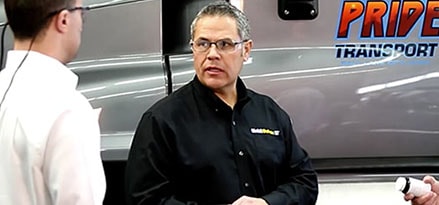Running a commercial vehicle fleet is a constant challenge. Competition continues to ramp up. Margins are being squeezed. Regulations are more complex. Technology is more advanced than ever. In such a tough environment, energy efficiency may not be at the top of your long list of priorities. But making it an area of focus for your business could make a real difference.
Operating more efficientlyMaybe you focus on fuel efficiency at the moment. Or, in your office, you look for ways to streamline your operation. Looking for efficiencies across your business – from simple changes in the office to investments in the latest technology on the road – is a holistic approach that can really impact the bottom line. This guide provides a straightforward look at immediate and long-term steps you can take to help establish a more efficient, successful business.
Saving energy on the road
Consistently achieving top performance from commercial vehicles is a major challenge. However, a properly maintained fleet can contribute to improved performance and fuel efficiency. Here are a few tips on how to get the most from your vehicles on the road.

Lubricants
Take note of the vehicle manufacturer’s guidance on oil change intervals, but more than that, consider the type of oil used too. Advanced, high-performance lubricants can help reduce fuel costs. Switching from a mineral engine oil to a low viscosity, full synthetic alternative has many benefits. Whether you’re hauling trailers in summer heat or moving supplies during the depths of winter, synthetic lubricants provide excellent protection.
Designed to deliver improved performance for longer periods, tests have shown that a change from mineral to low viscosity synthetic lubrication in commercial vehicles also provides potential for significantly improved fuel economy* on the road, and better protection against wear and deposit formation, which can cause costly maintenance bills. For these reasons, a switch to low viscosity synthetic lubrication across your fleet may ultimately help improve your bottom line.
*Product-specific example: Mobil Delvac 1 ESP 5W-30 helps improve fuel economy up to 2.6% in city driving conditions” with footnote “A fuel economy evaluation was conducted using two Volvo FH500 6x2 Euro 6 trucks, loaded to 60% payload (circa 32,000kg). Testing was conducted on track at the Millbrook Proving Ground, Ltd. in the United Kingdom. Statistically significant fuel economy benefits were observed in the Volvo trucks when comparing Mobil Delvac 1 ESP 5W-30 to a mineral 15W-40 engine oil with an average fuel economy(2) gain of 2.6% for city driving conditions. (1) Fuel economy improvements are dependent on vehicle/equipment type, outside temperature, driving conditions and your current fluid viscosities. (2) Corrections were applied when changes in test environment had a statistically significant impact on fuel economy.
Aerodynamic vehicle enhancements
Retrofitting heavy vehicles with drag-reducing devices can result in high fuel-savings – potentially up to almost 9 percent of fuel cost of a vehicle doing annual mileage of 80,000 miles. Results show that the performance of these aerodynamic devices depends on their functions and how the vehicles are operated. Vehicles on long-haul routes generally save twice as much fuel as those in urban areas.†
†Filippone A, Mohamed-Kassim, Z, 2010, Fuel savings on a heavy vehicle via aerodynamic drag reduction, Transportation Research Part D Transport and Environment.
Helpful tips: Driver training
Equally as important as equipment efficiency measures in commercial vehicles is driver training. There are many measures that can be taken to help drive more energy- and cost-efficiently.
| Training principle | How to increase efficiency |
|---|---|
| Gear changes | Train your drivers to operate in as high a gear as possible and to skip gears when practical. |
| Brakes | Braking wastes energy, so anticipate potential hazards and take preventive measures early to reduce the number of times and level of pressure applied to the brakes. |
| Finding the "sweet spot" | Drivers should find the speed at which the truck’s fuel economy is at its optimum rate and use it wherever possible. Find out from the truck manufacturer where the truck engine’s "sweet spot" is and help drivers identify it. This is where the engine’s rotational speed is at its most efficient. Obtain information on vehicle performance characteristics from dealers or suppliers, ensure that drivers know the performance characteristics of their vehicles and mark the most economical range on rev counters using green tape.‡ |
| Build on momentum | Drivers should use the momentum a truck gathers on flat terrains to get over uneven or hilly areas more economically. It pays to plan ahead, especially when entering road features and roundabouts. Keep brake applications to a minimum and take advantage of the topography to keep moving with the least energy possible. |
‡Always respect local driving and transport legislation as well as vehicle manufacturer’s operating manual.
Telematics
To manage a fleet efficiently, understanding where your vehicles are and how they are being used is vital. Telematics is one way to achieve a competitive advantage. By using this technology, you can track your fleet’s location, speed, fuel use, driver performance and more – all in real time. Telematics provide increased visibility, which leads to smart decisions that can help save money.
Tires
Checking tires is simple but essential. While it’s widely acknowledged that well-looked-after tires help reduce the risk of accidents, commercial vehicles are especially susceptible to the additional problems that come with unchecked tires. How costly can it be? The increased fuel consumption from underinflated tires is twice as high for heavy goods vehicles as it is for cars. So, how can you avoid this and ensure a safer, more efficient drive?
Helpful tips: Tires
- Ensure correct pressure: Low pressure can increase rolling resistance and waste fuel. Tires at the optimal pressure, with good grip, are critical to operating safely.
- Perform regular checks: By regularly checking tires, problems can be picked up early and adjustments made to keep the fleet running at the optimum rate. This should be an essential part of a regular maintenance routine, performed at least twice a month.
- Consider outside temperatures: Hotter outside temperatures will expand the air in tires, raising the pressure, while cooler temperatures will cause a reduction. Check tire pressure regularly to ensure your fleet is performing at optimum efficiency.
- Upgrade to fuel-efficient tires: Leading tire manufacturers have developed advanced options to help reduce fuel consumption.
-

API CK-4 or FA-4?
Find out which oil is right for your trucks. See our OEM heavy-duty equipment chart for CK-4 and FA-4 product recommendations.
Learn more about API CK-4 and FA-4 oils -

Mobil Delvac™ services
Learn how Mobil Delvac™ heavy-duty diesel engine oils and ExxonMobil’s lubricant technology expertise can help your fleet.
Learn more about Mobil Delvac™ services -

Fleet performance
Keep your trucks and your business going strong with the latest industry information, PC-11 oil recommendations and energy efficiency tips.
Learn more about Fleet performance -

Volvo Supertruck
ExxonMobil engineers supported Volvo in developing its new SuperTruck. Learn about the benefits of Volvo’s futuristic, heavy-duty concept vehicle.
Learn more about the Volvo SuperTruck

